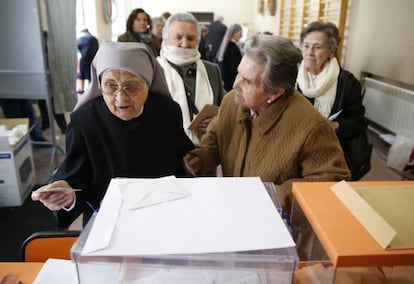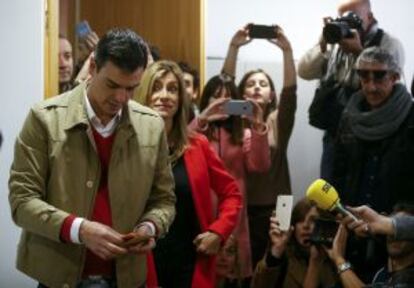How the day’s voting unfolded
No major incidents but plenty of anecdotes reported at some of the 57,511 polling stations

As Spaniards went to the polls in a watershed election on Sunday, overall turnout by 6pm was slightly higher than in 2011.
With two hours to go before polling stations closed, participation was 58.36%, less than one percentage point higher than four years ago.
Broken down by regions, Madrid and Valencia together led the national participation chart with 63% each.
In Barcelona, Mayor Ada Colau realized that she had lost her ID card and was forced to return home for her passport
In Catalonia, where the political scene is further complicated by the secessionist drive, turnout was 56.64%.
In the large southern region of Andalusia, 55.77% of eligible voters had exercised their right to cast their ballot.
Analysts have been predicting a turnout as high as 80% in an election that is expected to end the two-party dominance that the conservative Popular Party (PP) and the Socialist Party (PSOE) have enjoyed since the early 1980s.

Participation has been notably higher in postal voting, with this election seeing a 14.45% increase in applications for absentee ballots. A total of 771,860 people are voting this way on a day that caught some Spaniards already away for the Christmas holidays.
All the main prime ministerial candidates had already voted by 6pm. The incumbent, Mariano Rajoy of the PP, cast his ballot in Aravaca, a town northwest of the capital, where he called the good turnout figures “comforting.”
His Socialist challenger, Pedro Sánchez, voted at 11.15pm in Pozuelo, another town northwest of Madrid, stating that “we are going to write the future with our vote.”
Albert Rivera, leader of liberal newcomer Ciudadanos, voted in L’Hospitalet de Llobregat (Barcelona), where he called on people to head out to polling stations.
Pablo Iglesias, leader of anti-austerity party Podemos, was the last of the four main contenders to cast his vote. Speaking at Tirso de Molina High School in Vallecas, a blue-collar district of Madrid, he said Spain was undergoing “a second transition.”
Of the 10 general elections held since June 1977 – nearly two years after the death of dictator Francisco Franco – the highest turnout was registered in 1982 (79.97%) when the Socialists sailed to an absolute majority under Felipe González.
Spaniards are choosing 350 congress members under a voting system of closed lists that is skewed in favor of the two top performers, as well as electing 208 senators.
#EleccionesGenerales2015 Entre estas 2 imágenes han pasado 38 años de historia democrática en España pic.twitter.com/L00D4GCpvP
— Ministerio del Interior (@interiorgob) December 20, 2015
A controversial tweet
Although no incidents of note have been registered throughout the day at the 57,511 polling places, the social media was buzzing with angry reactions to an image tweeted by the Interior Ministry at 12.08pm, depicting an old black-and-white shot of late 1970s prime minister Adolfo Suárez casting his vote and a parallel one of Rajoy doing the same. Under the pictures, a caption read: “Between these two images, 38 years of democratic history have elapsed in Spain.”
Dozens of users wondered if it was even legal to publish such content.
“Is it not a crime to use the account of an official agency for crass electioneering on an election day?” wondered a high-school teacher.
“Yes, 38 years of history, but with a great difference! In black and white, you have political decency; in color you have indecency,” wrote a Socialist politician from Cáceres.
A day filled with anecdotes
Anecdotes of the day included the rapid closing of the station in Villarroya (La Rioja), which opened at 9am and shut one minute later because all six eligible voters there had already cast their ballots.
In Madrid, authorities reported that a woman in the district of San Blas was arrested when she began insulting voting officials for not letting her prove her identity with a photocopy of her ID card.
In Cantillana (Seville), the polling place opened later than expected because the presiding official had his car stolen with all his election paperwork inside.
And in Badajoz, one voting official was unable to produce the document proving that he had been selected to oversee the vote because “my daughter ate it.”
In the Canary Islands, officials who arrived at a polling station in Garachico (Tenerife) found that the lock had been filled with silicone.
And in Barcelona, Mayor Ada Colau realized that she had lost her ID card and was forced to return home for her passport.
English version by Susana Urra.
Tu suscripción se está usando en otro dispositivo
¿Quieres añadir otro usuario a tu suscripción?
Si continúas leyendo en este dispositivo, no se podrá leer en el otro.
FlechaTu suscripción se está usando en otro dispositivo y solo puedes acceder a EL PAÍS desde un dispositivo a la vez.
Si quieres compartir tu cuenta, cambia tu suscripción a la modalidad Premium, así podrás añadir otro usuario. Cada uno accederá con su propia cuenta de email, lo que os permitirá personalizar vuestra experiencia en EL PAÍS.
¿Tienes una suscripción de empresa? Accede aquí para contratar más cuentas.
En el caso de no saber quién está usando tu cuenta, te recomendamos cambiar tu contraseña aquí.
Si decides continuar compartiendo tu cuenta, este mensaje se mostrará en tu dispositivo y en el de la otra persona que está usando tu cuenta de forma indefinida, afectando a tu experiencia de lectura. Puedes consultar aquí los términos y condiciones de la suscripción digital.
Archived In
Últimas noticias
The complicated life of Francesca Albanese: A rising figure in Italy but barred from every bank by Trump’s sanctions
Half of Scotland is in the hands of 420 property owners
Pinochet’s victims grapple with José Antonio Kast’s rise in Chile
Reinhard Genzel, Nobel laureate in physics: ‘One-minute videos will never give you the truth’
Most viewed
- Pablo Escobar’s hippos: A serious environmental problem, 40 years on
- Why we lost the habit of sleeping in two segments and how that changed our sense of time
- Charles Dubouloz, mountaineering star, retires at 36 with a farewell tour inspired by Walter Bonatti
- Reinhard Genzel, Nobel laureate in physics: ‘One-minute videos will never give you the truth’
- The Florida Keys tourist paradise is besieged by immigration agents: ‘We’ve never seen anything like this’








































